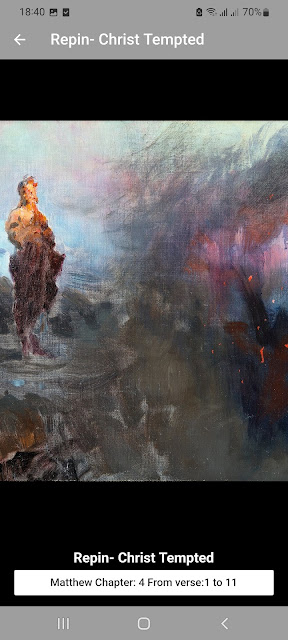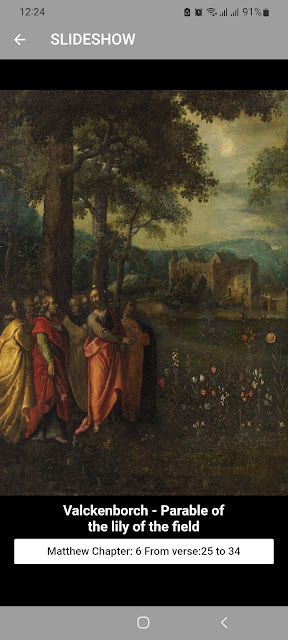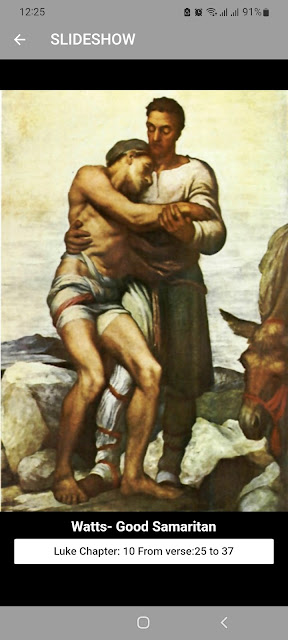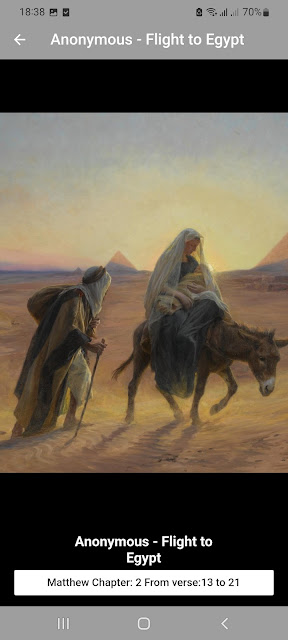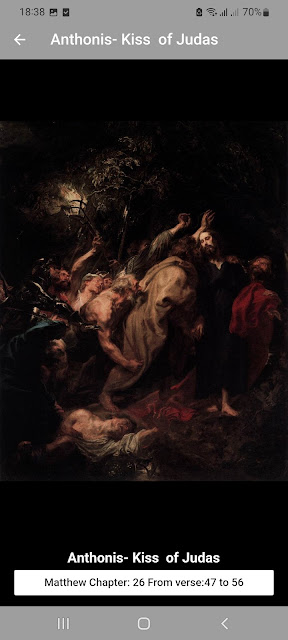Our Jesus Painting on Canvas App has hundreds of paintings from the Renaissance period and more recent times, viewable in museums and art galleries all over the world. Our app applies to all branches of Christianity; catholic, evangelicals, orthodox, etc
a) Repin Christ Tempted Matthew 4:1-11
View more Images here
In this painting, the devil tempts using the world, the flesh, and pride. Christ is offered bread, power, and the world as a whole if only he would worship him. This is no different from the assaults we all face today. What profit is there to gain the whole world, for the loss of an eternal soul?
View more Images here
In this painting, the devil tempts using the world, the flesh, and pride. Christ is offered bread, power, and the world as a whole if only he would worship him. This is no different from the assaults we all face today. What profit is there to gain the whole world, for the loss of an eternal soul?
Our biggest problem with temptation starts with Pride. The second we view ourselves as better than others and masters of our own destiny, we will attribute personal wherewithal to our own abilities and forget that were just created beings. The tempter knows how to massage our egos and make us forget our own mortality.
Anything that sees us advantage ourselves at the expense of others accounts for wickedness. This advantage stems from traits and thoughts that place us on a pedestal over a similar creation. It's the only way you can explain why we would take advantage of anyone for ur own material or other benefits.
For example, slavery both in its harsh form or more subtle modern form would not exist if the master did not view himself as better than the servant; (the Qatar Olympics is full of this). A thief will see himself as cleverer since he takes a much shorter time to achieve the same results as one that has to work hard to achieve the same end. The examples are innumerable.
The tempter first appeals to your pride and offers you all that you desire and thereafter takes your soul; a commodity that is eternal and priceless for what is terrestrial and fickle; it's an unfair trade-off.
b) Hunt The Boy Jesus found in the temple Luke 2:41-52
At about the age of 13, Jesus strays from his parent's caravan while in Jerusalem for the feast of Passover. After 3 days journey on their way back, they realized that he was missing and they thus returned to the city. They found him in deep discussion with the Pharisees and scribes in the temple. On questioning him, he asked his parents, "did you not know that I must attend to my father's work"? Cheeky of him... though it's followed by ... "he was obedient to them henceforth...
c) Tissot The rich man in hell, reaches out to Lazarus in heaven Luke 15:13-23
The sum total of one's life lies in the words of our Lord, "what did you do for me while you lived? Whatever you did for the least of these, you did for me". A life of serving the self leads to a life separate from God in the heavenly realm. The rich man realized this too late.
As in the case of all parables, they apply at the individual or community level. How we treat each other communally, affects us individually. Wealth is great, but arrogating talents to obtain wealth, without considering the giver of such talents, is foolish. Wealth is a gift that comes from talents endowed on you by the creator. Enjoy what you have, but you have a responsibility to share the benefits received from God with your neighbors. It does not mean that the poor can demand it after all altruism cannot be forced, but anyone raised in this community of believers, must of necessity act accordingly, otherwise, can they claim to be Christians?
The story depicted in this Christian Paintings with scripture, of the Rich Man and Lazarus, is a powerful and poignant parable that highlights the contrast between wealth and poverty, as well as the importance of living a life of faith and obedience to God. The parable also highlights the reality of eternity and the consequences of the choices we make in life.
One of the key themes in the story is the danger of wealth and luxury. The rich man in the story lived a life of extravagance, ignoring the needs of the poor man who lay at his gate. The rich man's wealth and luxury blinded him to the reality of his own sin and the consequences of his actions. This serves as a warning to all those who have wealth and privilege, reminding them that wealth and material possessions are not a guarantee of salvation or a ticket to heaven.
Another important theme in the story is the divide between heaven and hell. The rich man was in torment in hell, while Lazarus was at peace in heaven. The chasm between the two realms was unbridgeable, and no one could cross it. This serves as a reminder of the reality of eternity and the importance of making the right choices in life. Those who reject God's word and live lives of sin and disobedience will face eternal judgment, while those who put their faith in God and live lives of obedience will enjoy eternal life in heaven.
The parable also highlights the importance of listening to God's word and responding in faith. The rich man asked Abraham to send someone from the dead to warn his brothers, but Abraham told him that they had already been warned through Moses and the Prophets. This serves as a reminder that God's word is sufficient and that we should listen to it, rather than waiting for a miraculous sign.
Overall, the story of the Rich Man and Lazarus is a powerful and sobering reminder of the realities of eternity, the dangers of wealth and luxury, and the importance of responding in faith to God's word. It serves as a call to repentance and a warning to all those who would ignore the needs of the poor and live lives of sin and disobedience. The story is a powerful reminder of the importance of putting our faith in God and living lives of obedience and faithfulness to him.
d) Valckenborgh parable of the Lilly in the field Matthew 6:25-35
The Parable of the Lily of the Field is a powerful and reassuring teaching that encourages listeners to focus on God's provision and not be consumed by worries and anxieties. This parable has several key themes that are worth exploring in more detail:
The beauty of nature: The lilies of the field are known for their beauty and fragility. This highlights the idea that even the smallest and seemingly insignificant things in nature are beautiful and valuable in God's eyes. This is a reminder that God's creation is full of beauty and wonder, and that he values all of his creation, not just human beings.
God's provision: The Lord emphasizes that God clothes the lilies of the field and that he will much more surely provide for his people. This is a reminder that God is our provider and that he is concerned with all aspects of our lives, including our material needs. We can trust in God to provide for us and to take care of us, just as he takes care of the lilies of the field.
The dangers of anxiety and worry: Christ encourages his listeners not to worry about what they will eat, drink, or wear. He is reminding us that anxiety and worry are unproductive and can lead to stress and unhappiness. Instead, he calls us to trust in God and to focus on the present moment, knowing that he will provide for our needs.
The importance of faith: The parable concludes with Christ challenging the faith of his listeners, calling them "O you of little faith". This is a reminder that faith is an important part of our relationship with God and that we should trust in him and not in our abilities or possessions. By focusing on God's provision and putting our faith in him, we can live a life of peace and contentment.
The transience of material wealth: The Lord reminds us that the lilies of the field, although beautiful and valuable, will eventually die and be thrown into the oven. This is a reminder that all material wealth and possessions are temporary and that our focus should be on God and not on material things.
Overall, the Parable of the Lily of the Field is a rich and meaningful teaching that encourages us to focus on God's provision, trust in him, and not be consumed by worry and anxiety. By focusing on God and putting our faith in him, we can live a life of peace and contentment, knowing that he will take care of us.
e) Watts the parable of the good Samaritan Luke 12:25-32
The story starts with a lawyer, an expert in religious law, asking the Lord a question to test him: "What must I do to inherit eternal life?" The Lord responds by asking the lawyer what is written in the law, and the lawyer cites the two greatest commandments: to love God with all one's heart, soul, strength, and mind, and to love one's neighbour as oneself. Jesus then tells the parable to emphasize the importance of putting these commandments into practice.
In the parable, a man is travelling from Jerusalem to Jericho, a dangerous road known for attacks by robbers. The man is indeed robbed, beaten, and left for dead. A priest and a Levite, both religious leaders, come across the man but choose to walk on the other side of the road, perhaps out of fear for their safety or due to religious restrictions that would make them unclean if they touched a wounded person. But a Samaritan, a member of a hated and ostracized ethnic group, comes across the man and shows mercy. The Samaritan dresses the man's wounds, takes him to an inn and pays the innkeeper to care for him. The next day, the Samaritan checks on the man and gives the innkeeper additional funds for his care.
In conclusion, the Parable of the Good Samaritan teaches that anyone, even those from different cultures, religions, or social classes, can be a neighbour in need of help and compassion. Loving one's neighbour involves practical acts of kindness and generosity, regardless of the circumstances or personal cost. The parable challenges listeners to go beyond the letter of the law and to love others as they would love themselves, to show mercy and compassion to those in need. At the level of the nation, we are being told that we should be charitable towards each other. How can we ask God for mercy if we are unmerciful towards each other?
f) Manet Jesus Mocked John 19:1-16
f) Manet Jesus Mocked John 19:1-16
The scene of Christ being mocked by the soldiers is described in the New Testament, particularly in the Gospels of Matthew (27:27-31), Mark (15:16-20), and John (19:1-3). According to these accounts, after He was arrested and brought before the Roman governor Pontius Pilate, he was handed over to the soldiers to be scourged and mocked.
The soldiers, who were known for their cruelty, stripped Him of his clothes and put a scarlet robe on him, a symbol of his shame and humiliation. They then twisted together a crown of thorns and placed it on his head, pressing it down so that it dug into his scalp. They also placed a reed in his right hand as a mock scepter and knelt in front of him, pretending to pay homage to him. The soldiers mocked Him, saying "Hail, King of the Jews!" and struck him with the reed, spat on him, and took the reed from him to beat him.
This scene is a powerful depiction of the cruel treatment he received before his crucifixion. It highlights the extent to which Jesus was willing to suffer for the sake of others and the sake of God's kingdom. Despite the mocking and cruelty he endured, He remained steadfast in his mission, showing love and forgiveness to those who crucified him.
In the broader context of the New Testament, the scene is a reminder of the ultimate sacrifice he made on behalf of humanity. Through his death and resurrection, Jesus made a way for people to be reconciled with God and to have eternal life. The scene of his mocking is a powerful testimony to the love and grace of God, and an encouragement for believers to follow the example of love and sacrifice.
g) Flight to Egypt Matthew 2:12-21
The flight of to Egypt is described in the New Testament, in the Gospel of Matthew (2:13-15). According to this account, after Jesus was born in Bethlehem, an angel of the Lord appeared to Joseph in a dream and told him to take the infant Jesus and his mother, Mary, and flee to Egypt to escape the wrath of King Herod. Herod was seeking to kill the child, who had been born as the "King of the Jews," as he saw the child as a threat to his rule.
So Joseph took Mary and the infant to Egypt, where they stayed until Herod died. Then, in another dream, an angel of the Lord told Joseph to return to Israel, as it was safe to do so. Joseph and his family returned to their home in Nazareth in the region of Galilee.
The flight to Egypt is significant in several ways. Firstly, it underscores the danger that the Lord faced even as a child and the lengths to which his family went to protect him. Secondly, it highlights the fulfilment of a prophecy in the Old Testament, in the book of Hosea (11:1), where God says, "Out of Egypt I called my son." This verse is seen as a reference to the Israelites' deliverance from slavery in Egypt, and also to the flight of Jesus to Egypt as a young child.
Finally, the flight to Egypt also highlights the international character of Jesus' ministry and the universality of the message he came to proclaim. From his birth in Bethlehem to his upbringing in Nazareth and his eventual ministry throughout the Roman Empire, His life and message transcended national, cultural, and linguistic boundaries, and continue to have a global impact to this day.
h) Anthonis Art Kiss of Judas Matthew 26:47-56
The "Kiss of Judas" refers to the event described in the New Testament, particularly in the Gospels of Matthew (26:47-49), Mark (14:43-45), and Luke (22:47-48), where Judas Iscariot, one of the twelve apostles betrayed the Lord with a kiss.
According to these accounts, Christ was arrested in the Garden of Gethsemane and brought before the religious leaders and the Roman governor Pontius Pilate. To identify the Lord to the soldiers who came to arrest him, Judas betrayed him with a kiss, a common form of greeting in that time and culture. This kiss, however, was not one of affection but of treachery, as it signalled to the soldiers who Jesus was and facilitated his arrest.
The "Kiss of Judas" is seen as a turning point in the passion of Christ and is a powerful symbol of betrayal, treachery, and sin. It highlights the extent to which even those closest to Jesus can turn against him, and serves as a reminder of the danger of sin and the need for forgiveness and grace.
In the broader context of the New Testament, the "Kiss of Judas" is part of the larger story of Christ's sacrifice on the cross for the sins of humanity. Through His death and resurrection, He provides a way for people to be forgiven and reconciled with God, even in the face of their sins and treachery.
The "Kiss of Judas" remains a powerful and evocative story, reminding us of the fragility of human relationships, the power of sin, and the need for God's grace and forgiveness.
I have never quite understood Judas' motives. Initially greed, but thereafter the shame of what he had done led him to suicide. Why he would kill himself even after repenting seems unfortunate. It is not for me to say, but God's mercy knows no limits; so hopefully, even in his case, mercy was shown.
I disagree with the church about the depravity of Judas. Indeed what he did was wrong, however, is he not to be accorded the same mercy as say, St Peter, who disowned the Lord twice before the cock crowed thrice? It is not for me, and dare I say not the church to measure the extent of God's mercy.
According to these accounts, Christ was arrested in the Garden of Gethsemane and brought before the religious leaders and the Roman governor Pontius Pilate. To identify the Lord to the soldiers who came to arrest him, Judas betrayed him with a kiss, a common form of greeting in that time and culture. This kiss, however, was not one of affection but of treachery, as it signalled to the soldiers who Jesus was and facilitated his arrest.
The "Kiss of Judas" is seen as a turning point in the passion of Christ and is a powerful symbol of betrayal, treachery, and sin. It highlights the extent to which even those closest to Jesus can turn against him, and serves as a reminder of the danger of sin and the need for forgiveness and grace.
In the broader context of the New Testament, the "Kiss of Judas" is part of the larger story of Christ's sacrifice on the cross for the sins of humanity. Through His death and resurrection, He provides a way for people to be forgiven and reconciled with God, even in the face of their sins and treachery.
The "Kiss of Judas" remains a powerful and evocative story, reminding us of the fragility of human relationships, the power of sin, and the need for God's grace and forgiveness.
I have never quite understood Judas' motives. Initially greed, but thereafter the shame of what he had done led him to suicide. Why he would kill himself even after repenting seems unfortunate. It is not for me to say, but God's mercy knows no limits; so hopefully, even in his case, mercy was shown.
I disagree with the church about the depravity of Judas. Indeed what he did was wrong, however, is he not to be accorded the same mercy as say, St Peter, who disowned the Lord twice before the cock crowed thrice? It is not for me, and dare I say not the church to measure the extent of God's mercy.
i) Blake Agony in the garden Mark 14:22-72
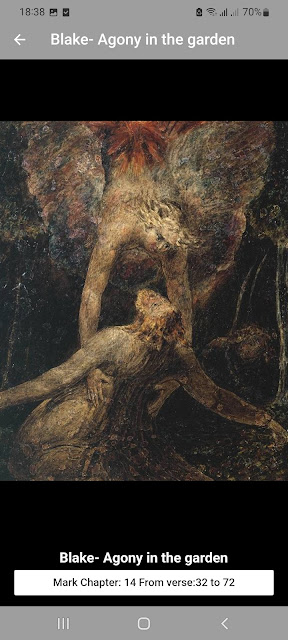
As he awaits the start of His passion, the Lord is assisted by angels to endure the anticipated moments of betrayal, loss, and pain to the very end.
The event of Jesus walking on the Sea of Galilee is described in the New Testament, in the Gospels of Matthew (14:22-33), Mark (6:45-52), and John (6:16-21). According to these accounts, Jesus and his disciples were in a boat, crossing the Sea of Galilee, when a strong wind arose, making it difficult for them to reach the other side. In the middle of the night, Jesus came to them, walking on the water, and they were frightened, thinking he was a ghost.
Jesus spoke to them, saying, "Take courage! It is I. Don't be afraid." Peter, one of the disciples, asked Jesus to command him to come out to him on the water, and Jesus agreed. Peter stepped out of the boat and began to walk on the water towards Jesus, but when he saw the wind and the waves, he became afraid and began to sink. Jesus reached out and caught him, saying, "You of little faith, why did you doubt?"
The event of Jesus walking on the water is seen as a demonstration of his divine power and a manifestation of his control over the forces of nature. It is also a powerful symbol of his role as the Savior of the world, as he comes to his disciples amid their difficulties and fears and offers them peace and security.
Furthermore, the episode with Peter walking on the water highlights the theme of faith in the Gospels. Peter's initial faith and willingness to step out of the boat and walk on the water is a demonstration of the power of faith, but his subsequent fear and doubt when he saw the wind and the waves is a reminder of the need to remain steadfast in the faith, even amid difficulties.
The story of Jesus walking on the Sea of Galilee continues to be powerful and inspiring, reminding us of the divine power of Jesus and the importance of faith in our own lives.
Enjoy
